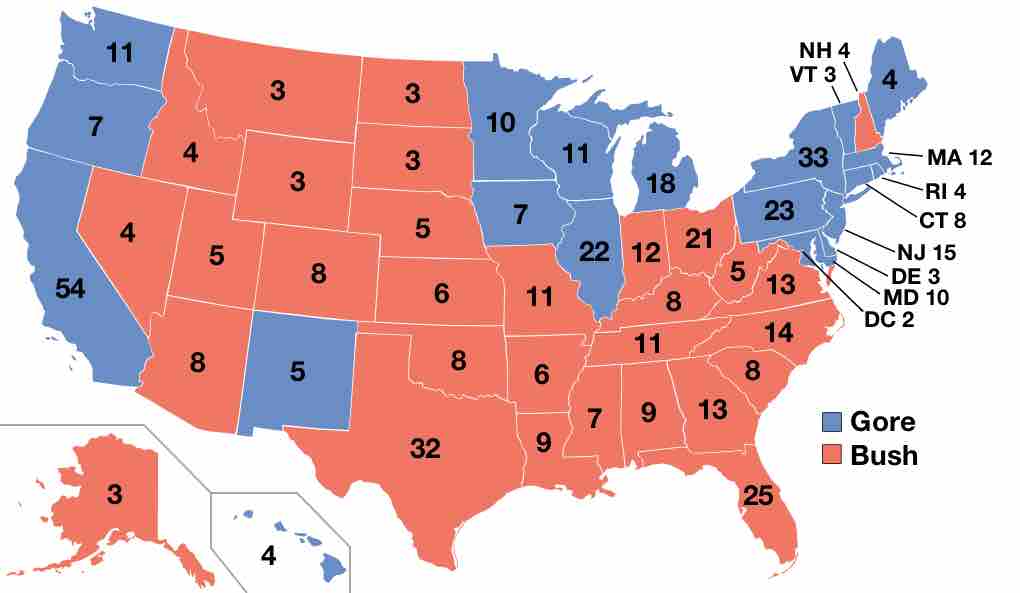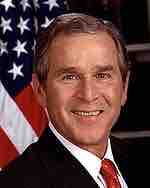The 2000 Election
The United States presidential election of 2000 was a contest between Republican candidate George W. Bush, then-governor of Texas, and Democratic candidate and incumbent Vice President Al Gore. Bush narrowly won the November 7 election with 271 electoral votes to Gore's 266 (with one elector abstaining in the official tally). Though Gore came in second in the electoral vote, he received 543,895 more popular votes than Bush.

2000 Presidential Electoral College Votes
Presidential election results map: red denotes states won by Bush/Cheney, Blue denotes those won by Gore/Lieberman.
The election was noteworthy for a controversy over the awarding of Florida's 25 electoral votes, the subsequent recount process in that state, and the unusual event of the winning candidate having received fewer popular votes than the runner-up. Later research showed that by the standards requested by the Gore campaign, Bush would have won the recount. However, had the Gore campaign asked for a full statewide recount, the same research indicates that Gore would have probably won the recount by about 100 votes, consequently giving him Florida's electoral votes and victory in the presidential election.
The Candidates
Democratic Candidates
Al Gore of Tennessee was a consistent front-runner for the nomination. Gore easily defeated the other main Democratic candidate Bill Bradley in the primaries, largely because of support from the Democratic Party establishment and Bradley's poor showing in the Iowa caucus. Al Gore unanimously won the Democratic nomination at the Democratic National Convention, and Connecticut Senator Joe Lieberman was nominated for Vice President.

Al Gore
Portrait of 2000 Democratic Presidential Nominee Al Gore
Republican Candidates
Several Republican candidates appeared on the national scene to challenge Gore's candidacy. George W. Bush became the early front-runner, acquiring unprecedented funding, a broad base of leadership support from his governorship of Texas, and the name recognition and connections of the Bush family. Several aspirants withdrew before the Iowa Caucus because they were unable to secure funding and endorsements sufficient to remain competitive with Bush. John McCain emerged as the main contender. However, Bush won the nomination, selecting former Secretary of Defense Dick Cheney as his running mate.

George W. Bush
Portrait of George W. Bush
Campaign Issues
Although the campaign focused mainly on domestic issues—such as the projected budget surplus, proposed reforms of Social Security and Medicare, health care, and competing plans for tax relief—foreign policy was often an issue. Bush criticized the Clinton administration's policies regarding Somalia and the Balkans. Gore, meanwhile, questioned Bush's fitness for the job, pointing to gaffes made by Bush in interviews and speeches, and suggesting the Texas governor lacked the necessary experience to be president.
Bill Clinton's impeachment cast a shadow on the Democratic campaign and on his vice president's run to replace him, and Gore and Lieberman studiously avoided the Clinton scandals. Ralph Nader was the most successful third-party candidate, drawing 2.74 percent of the popular vote. Many Gore supporters claimed Nader split the Democratic vote, tipping the election for Bush.
A Close Election
Florida: The Defining State
As election night wore on, the returns in a handful of small-to-medium sized states, including Wisconsin and Iowa, were extremely close; however, it was the state of Florida that would make clear the winner of the election. As the final national results were tallied the following morning, Bush had clearly won a total of 246 electoral votes, while Gore had won 255 votes. 270 votes were needed to win. Florida's 25 electoral votes became the key to an election win for either candidate. The outcome of the election was not known for more than a month after the balloting ended because of the extended process of counting and then recounting Florida's presidential ballots.
Florida Recount
The final result in Florida was slim enough to require a mandatory recount (by machine) under state law; Bush's lead had dwindled to about 300 votes by the time it was completed later that week. A count of overseas military ballots later boosted his margin to about 900 votes.
Most of the post-electoral controversy revolved around Gore's request for hand recounts in four counties, as provided under Florida state law. In the highly controversial decision Bush v. Gore, the Supreme Court ruled in a 7–2 vote that the Florida Supreme Court's ruling requiring a statewide recount of ballots was unconstitutional, and in a 5–4 vote that the previously certified total should hold.
Election Reform and Voting Machines
Because the 2000 presidential election was so close in Florida, the U.S. government and state governments pushed for election reform to be enacted before the 2004 election. Many of Florida's election night problems stemmed from usability and ballot design factors with voting systems. A proposed solution to these problems was the installation of modern electronic voting machines. In the aftermath of the election, the Help America Vote Act (HAVA) was passed to help states upgrade their election technology in the hopes of preventing similar problems in future elections.